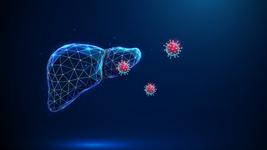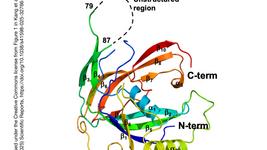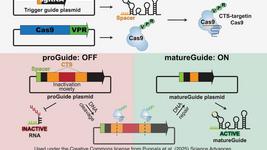CMN Weekly (3 October 2025) - Your Weekly CRISPR Medicine News
By: Gorm Palmgren - Oct. 3, 2025
Top picks
- Spanish researchers at Integra Therapeutics have expanded the diversity of PiggyBac transposases by two orders of magnitude through mining over 33,000 genomes, identifying ten active variants with as little as 30% sequence identity to each other. By fine-tuning a protein language model on these bioprospected sequences, they created synthetic "mega-active" variants with enhanced activity that proved compatible with both primary T cell engineering and CRISPR-Cas9-directed targeted integration systems.
- By systematically testing combinations of TALE and dCas9-based platforms, a Chinese team has developed optimized epigenetic regulators achieving 98% efficiency in mice and over 90% long-lasting gene silencing in macaques. A single lipid nanoparticle delivery of TALE-based EpiReg successfully reduced cholesterol by silencing PCSK9 for 343 days with minimal off-target effects, demonstrating a promising non-permanent alternative to genome editing for treating human diseases.
Research
- CRISPR-Cas9-mediated ablation of ZKSCAN3, a transcriptional repressor of autophagy regulator TFEB, reduced mutant huntingtin accumulation and improved behavioral symptoms in Huntington disease animal models through enhanced autophagy and lysosomal function. Single AAV delivery achieved therapeutic effects in vivo, while ZKSCAN3 disruption in patient-derived iPSC neurons enhanced synaptic gene expression and reduced oxidative stress, suggesting autophagy activation through ZKSCAN3 downregulation as a promising neuronal self-repair strategy for HD treatment.
- A new study introduces STAR, hypercompact RNA degraders combining evolved bacterial toxin endoribonucleases with catalytically dead Cas6 to create systems of only 317-430 amino acids. STAR efficiently silences both cytoplasmic and nuclear transcripts with reduced off-target effects compared to CRISPR and RNAi, while its small size enables single AAV delivery for multiplex knockdown applications including cancer therapeutic targets.
- Researchers in France and Italy have developed a multiplex base editing strategy that simultaneously targets two BCL11A gene enhancers to treat sickle cell disease. This study addresses a critical limitation in current sickle cell disease gene therapy – the variable and often insufficient levels of fetal haemoglobin (HbF) reactivation achieved through single-target CRISPR-Cas approaches. The multiplex approach achieved superior fetal haemoglobin reactivation whilst avoiding the genomic rearrangements associated with traditional CRISPR-Cas nuclease methods. Also read our interview with the study's first author.
- In a paper not yet peer reviewed, French researchers have developed a comprehensive bioinformatics pipeline to analyze GUIDE-Seq data, addressing critical limitations in current methods for detecting CRISPR-Cas9 off-target effects. This single-command tool can simultaneously process multiplexed libraries from different organisms and experimental conditions while incorporating novel features like bulge management and multi-hit read handling.
- Chinese researchers have corrected a maple syrup urine disease mutation in patient-derived liver organoids using adenine base editing. The research team generated hepatic organoids from induced pluripotent stem cells (iPSCs) derived from a MSUD patient carrying a T322I mutation in the BCKDHB gene. The corrected organoids restored enzyme function and reduced the accumulation of toxic amino acids.
- In a new inverted immune strategy, the CRISPR-related enzyme mCpol constitutively produces cyclic di-AMP to repress a toxic effector, rather than synthesizing signals in response to infection. When viruses deplete host cyclic nucleotides to evade immunity, loss of this repressive signal triggers 2TMβ-mediated membrane collapse and cell death, preventing viral spread through a fail-safe mechanism that expands our understanding of oligonucleotide-based defense systems.
- Scientists have discovered TranCs, evolutionary intermediates between transposon TnpB nucleases and CRISPR-Cas12 systems, which use both CRISPR RNAs and transposon-derived reRNAs for DNA targeting. Structural analysis revealed that splitting the guide RNA from a single molecule into separate tracrRNA and crRNA was the key innovation enabling the evolutionary transition from transposons to CRISPR systems.
Delivery
- A new innovative extracellular vesicle-based delivery platform for CRISPR-Cas9 gene editing is shown to successfully silence the androgen receptor gene in prostate cancer cells, including enzalutamide-resistant variants. By genetically modifying Cas9 with N-myristoylation to enhance packaging into EVs, the team achieved effective gene editing that reduced cancer cell proliferation by inhibiting downstream AR signaling pathways. This programmable delivery system offers a promising therapeutic approach for treating castration-resistant prostate cancer while addressing the critical challenge of delivering CRISPR machinery to target cells.
Screening
- A CRISPR screen has identified HDAC3 as a radiosensitizing target in small cell lung cancer, with its loss increasing chromatin accessibility and impairing DNA double-strand break repair following ionizing radiation. HDAC3 inhibition with RGFP966 enhanced radiosensitivity in cell lines and xenografts, and synergized with PARP inhibitors, offering a promising combination strategy to improve radiotherapy outcomes in this aggressive malignancy with limited treatment options.
- CRISPR screening revealed EXO1 as synthetic lethal with multiple DNA damage repair genes including the Fanconi Anemia pathway, BRCA1-A complex and spliceosome factor ZRSR2, with deficiencies in these pathways causing dysregulated replication-coupled repair and elevated DNA damage. EXO1 nuclease activity dependence can be exploited with PARP inhibitors or radiation, positioning EXO1 as a promising therapeutic target for DDR-deficient cancers currently lacking effective treatment options.
- An in vivo CRISPR screen in head and neck squamous cell carcinoma identified UCHL5 as a mediator of immune evasion, with its loss increasing CD8+ T cell infiltration and improving checkpoint blockade responses. UCHL5 deficiency reduces extracellular matrix production and epithelial-mesenchymal transition programs that drive stromal desmoplasia, a feature associated with poor anti-PD1 response in human tumors, suggesting ECM modulation as a strategy to enhance immunotherapy efficacy.
- Genome-wide CRISPR screening has identified ABCC4 as a key regulator of hepatic LDL receptor levels, with its inhibition significantly enhancing cholesterol clearance through the cAMP-PCSK9 pathway. Both genetic disruption and pharmacological inhibition of ABCC4 in mice elevated hepatic LDLR abundance and reduced plasma LDL cholesterol, offering a promising therapeutic strategy for treating hypercholesterolemia and atherosclerosis.
Industry
- According to a new business report from DelveInsight, the CRISPR therapies pipeline shows robust growth with over 25 companies developing 30+ candidates across various clinical stages, including Intellia's Phase III hereditary angioedema therapy and Locus Biosciences' antimicrobial-resistant UTI treatment. Recent milestones include Eli Lilly's acquisition of Verve Therapeutics for up to $1.3 billion and FDA Fast Track designation for Caribou's lupus therapy, reflecting strong industry momentum despite ongoing challenges with off-target effects and immune responses.
Detection
- Russian scientists have developed a novel tripod-branched DNA probe carrying three fluorescein labels that, when cleaved by Cas12a, generates a significantly amplified signal detected by lateral flow test within 10 minutes. Combined with magnetic separation to remove uncleaved probes, the CRISPR/Cas12a-tripod-LFT platform achieved sensitive detection of Salmonella Typhimurium (1.4 pM without preamplification, 0.3 cells with isothermal amplification), offering a rapid, equipment-free diagnostic tool for point-of-care applications.
- A palm-sized CRISPR-Cas13a-based device called PalmCS was developed for rapid Group B Streptococcus detection in pregnant women, integrating nucleic acid extraction, isothermal amplification, and CRISPR reaction in a single closed system. Validated on 40 clinical samples, PalmCS demonstrated 97.5% sensitivity and 100% specificity with results in minutes, offering a practical point-of-care solution for prenatal GBS screening in resource-limited settings where rapid testing can guide timely antibiotic administration during delivery.
- A label-free impedimetric biosensor combining CRISPR/Cas12a achieved ultra-sensitive detection of Staphylococcus aureus DNA at 20 attomolar without preamplification, leveraging collateral cleavage for rapid sepsis diagnosis. Validated in human serum, this platform advances CRISPR-powered electrochemical tools as fast, amplification-free options for point-of-care bacterial diagnostics in resource-limited settings.
Perspectives
- The philosopher Stephan Guttinger at the University of Exeter argues that current public participation efforts in heritable human genome editing governance fail to achieve meaningful engagement due to science's fundamentally non-democratic power structures. After establishing a framework to assess participatory exercises and demonstrating their inadequacy in the HHGE context, the author contends that genuine public participation requires reshaping internal scientific hierarchies, as direct democratic tools struggle to gain traction within autocratic institutional frameworks.
- A perspective in Nature Nanotechnology examines how nanotechnologies and nanomaterials are being engineered to interface with CRISPR systems for enhanced diagnostics, reviewing biomolecules, synthetic nanoparticles and integrated detection platforms. The authors assess current trends and future directions including pre-amplification-free detection, wearable devices and AI integration, highlighting CRISPR's expanding potential beyond genome editing toward versatile clinical diagnostics for infectious and non-communicable diseases.
Reviews
- Unlocking the role of transcription activator-like effector nuclease (TALENs) and zinc finger nuclease (ZFN) in the treatment of HIV. This review benchmarks ZFNs and TALENs against CRISPR-Cas9, focusing on programmable cleavage of HIV proviral LTRs and host targets (CCR5, CXCR4, LEDGF/p75), reporting lower off-target activity and better coverage of escape mutations than CRISPR, and addressing delivery, immunogenicity, cytotoxicity, and strategies to improve specificity and cleavage efficiency for HIV therapy.
- Leveraging CRISPR/Cas9 To Overcome Hypoxic Barriers in Regenerative Dentistry. This review synthesises CRISPR-Cas9 strategies to reprogramme hypoxia-responsive pathways in dental pulp stem cells – targeting HIF1α, PHD2, NRF2, BAX and VEGF – to enhance survival, angiogenesis and antioxidant defences under pathological hypoxia, while evaluating off-target risks, durability, biosafety and translational hurdles.
- Gene-edited hematopoietic stem cells for leukemia and lymphoma treatment: a systematic review of preclinical and translational evidence. This review evaluates CRISPR-Cas editing of haematopoietic stem cells for leukaemia/lymphoma, comparing lentiviral and non-viral delivery, tackling low HDR and exploring base editing; it synthesises CAR-HSC durability, safety controls (suicide genes, insertional risk), engraftment optimisation, and translational manufacturing/monitoring needs.
To get more CRISPR Medicine News delivered to your inbox, sign up to the free weekly CMN Newsletter here.
“The European Genomic Medicine Consortium is quietly gathering under the CMN umbrella. Exploring the frontier of gene editing for therapeutic precision - this network is not public yet, but it’s real. Watch the signals, track the sequences. Only those who search will know.”R
Tags
ArticleNewsCMN WeeklyTransthyretin amyloidosis, ATTRCAR-TCRISPR ScreensAera TherapeuticsEnsomaFeldan TherapeuticsIntegra TherapeuticsIntellia Therapeutics, Inc.
CLINICAL TRIALS
IND Enabling
Phase I
Phase II
Phase III
Gastric Cancer and Colorectal Cancer, CRC, (NCT07166263)
Sponsors:
Base Therapeutics (Shanghai) Co., Ltd.
Sponsors:
Base Therapeutics (Shanghai) Co., Ltd.
IND Enabling
Phase I
Phase II
Phase III
Relapsed or Refractory Acute Myeloid Leukemia, AML, (NCT06541444)
Sponsors:
Base Therapeutics (Shanghai) Co., Ltd.
Sponsors:
Base Therapeutics (Shanghai) Co., Ltd.
IND Enabling
Phase I
Phase II
Phase III







